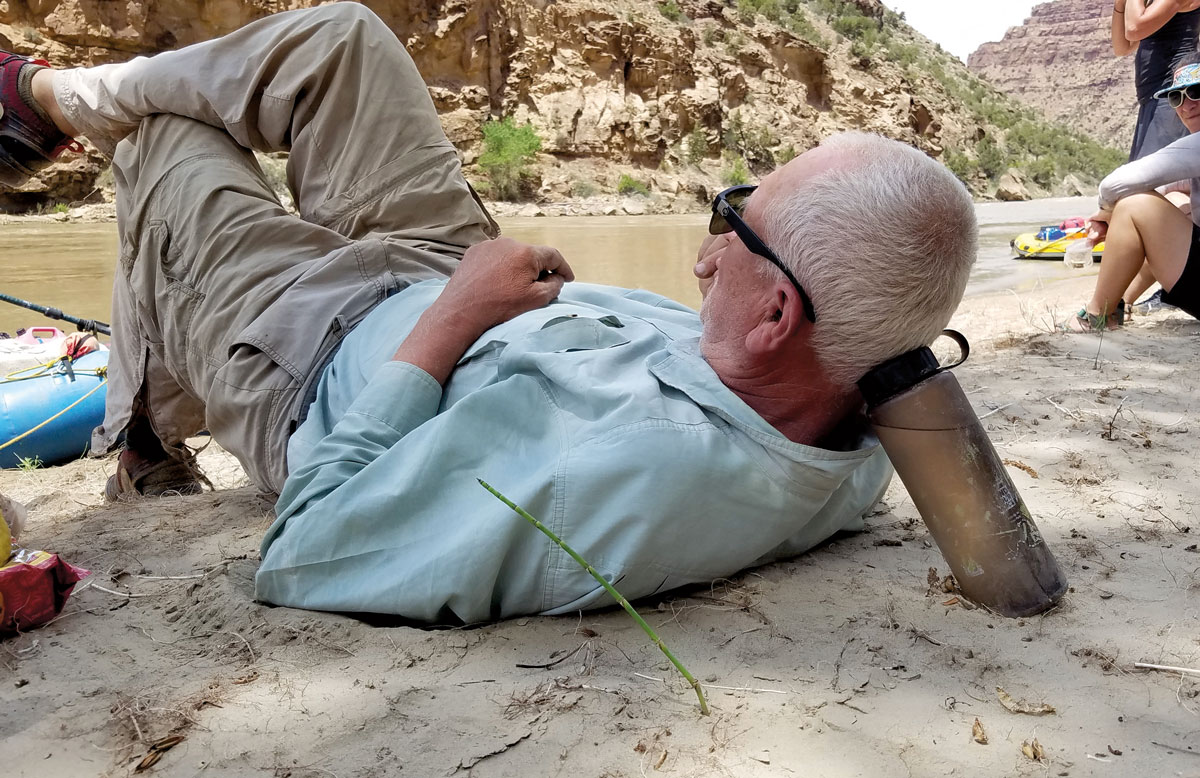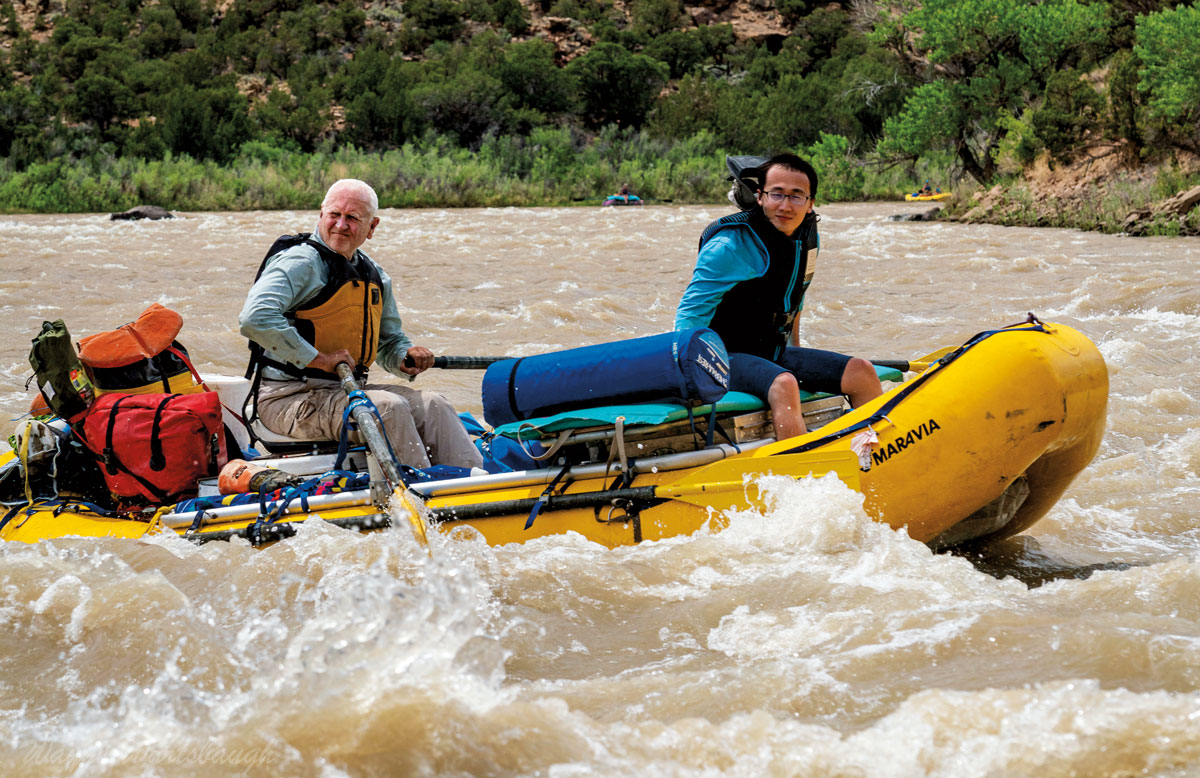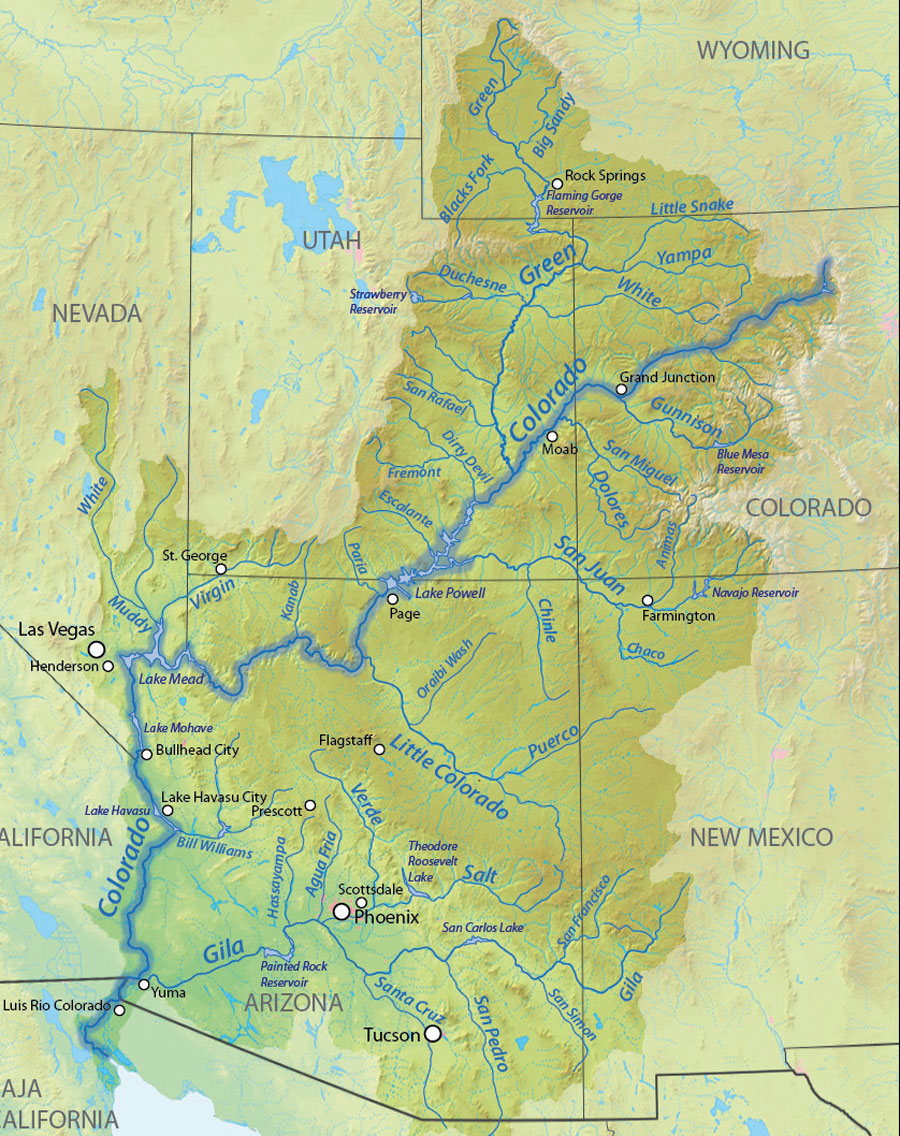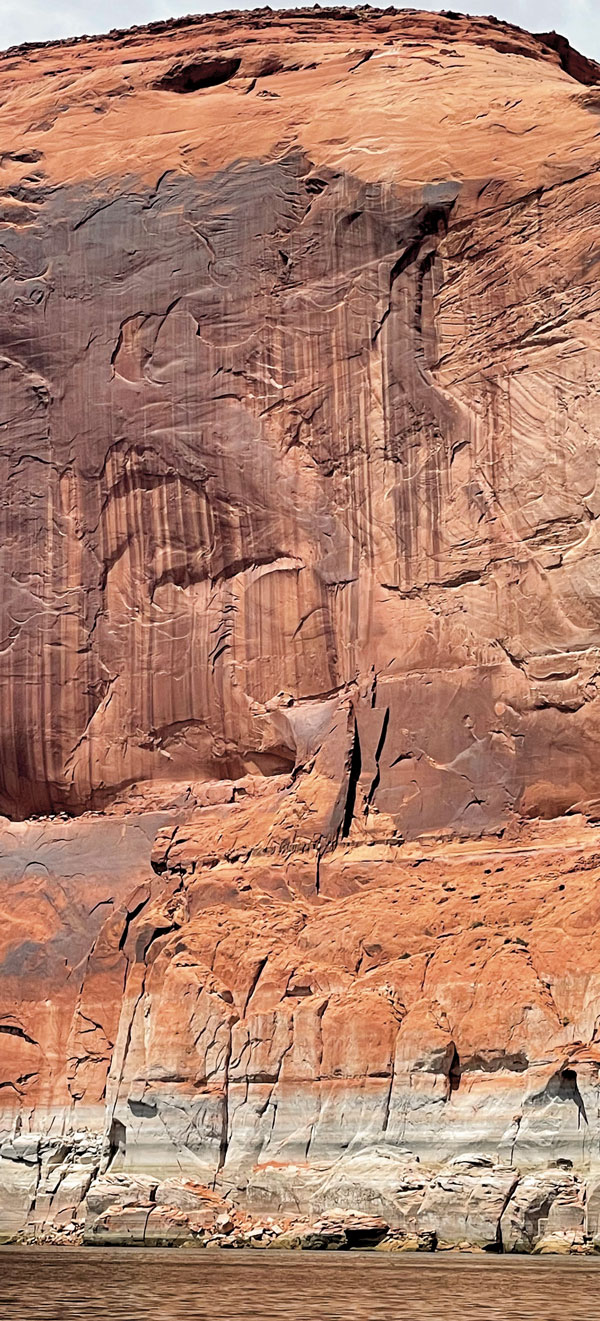
Troubled Waters
Forty million people. Seven states. And just one river to fill drinking glasses, bathe children and irrigate farmland.
Those who don’t live in the Colorado River Basin states of Arizona, California, Colorado, Nevada, New Mexico, Utah and Wyoming might think of the Colorado River as a whitewater playground cut right into the heart of the Grand Canyon. Included in Outside magazine’s list of the world’s 10 best whitewater rafting destinations, the Colorado River attracts visitors from around the globe.
Jack Schmidt ’72 understands the appeal. He still remembers his first rafting trip down the Colorado River in 1980 — an adventure the New Jersey native calls one of the highlights of his life. Forty years later, Schmidt still loves floating down the Colorado, but now the trips have a decidedly more urgent purpose.
Schmidt, a professor at Utah State University, is the director of the Center for Colorado River Studies. As one of the foremost experts on the complex web of environmental, geological and economic factors affecting the Colorado, he’s regularly asked to share his perspective on how to best ensure the future of a river that’s shrinking before our eyes.
“The reality is that today, every drop of water is used, such that zero water makes it to the sea,” Schmidt says. “And the pie — or the water supply — is getting smaller.”
Seeing Is Believing
This is a message impossible to convey through a Zoom screen or inside a lecture hall. Instead, Schmidt invites stakeholders to join him on the river itself. In addition to time spent on research, meetings and interviews, Schmidt leads expeditions down the Colorado River, showing water managers, scientists and other decision-makers just how dire the situation has become.
While there, they might see the “bathtub rings” around Lake Mead, the reservoir formed by the Hoover Dam that was last full in the late 1990s. He shows them Lake Powell, the other primary Colorado River reservoir, where boat ramps now lead to dirt and officials have forced many houseboats off the lake. And he invites them into his raft for a trip down the Colorado itself, pointing out markings above the waterline that indicate previous years’ historic lows.
While climate change has led to more rain and bigger floods in some parts of the United States, the Colorado River Basin has seen the opposite: less snowpack and faster drying. It’s gotten so bad that, on Aug. 16, 2021, federal officials declared the first-ever shortage on the Colorado River, prompting emergency supply cuts that will first affect farmers in Arizona, then residents from all seven states that rely on its water. Much of the river’s future is in the hands of policymakers who must broker new deals that will force their constituents to use less.
“There is no question that we are in a crisis right now,” Schmidt says. “But in that crisis is an opportunity to rethink what we’re doing.”
And the stakes are high for millions of Americans.
“Everybody is in the thick of it,” Schmidt says. “If you’re a Bucknell graduate who lives in Southern California or Phoenix or Tucson or Salt Lake or Denver or central New Mexico, you’re in the thick of it. How are we going to change? How are we going to live more sustainably with a declining water supply?”
Finding the Right Words
At Bucknell, Schmidt majored in political science and discovered — albeit too late to change majors — a passion for geology. He says the two fields complement each other perfectly in his Colorado River work, like a pair of tributaries uniting to form something deeper.
From Bucknell geology professors such as Ed Cotter, Schmidt gained a rich understanding of how rivers develop and evolve. From his political science classes, Schmidt explored how elected and appointed officials address thorny issues and learned to speak the language understood at committee meetings and inside statehouses.
This skill was tested from 2011 to 2014, when Schmidt took a leave from Utah State to serve as chief of the U.S. Geological Survey’s Grand Canyon Monitoring and Research Center, which conducts applied science to inform management of the Colorado River.


“That’s when I began to really understand how these big water-supply decisions affect the options and opportunities we have to restore and manage river ecosystems,” Schmidt says. “When I returned to the university, I committed myself to work at that intersection.”
Whether taking political appointees down the Colorado River in a raft or teaching students at Utah State’s Department of Watershed Sciences, Schmidt appreciates a good metaphor when explaining the river’s complexities.
Setting aside the environmental impacts that climate change is having on the river and focusing purely on the water resources available to the seven affected states and parts of Mexico, Schmidt likens the river to a checking account.
Water In, Water Out
Each winter, snow blankets the Rocky Mountains. Beginning in the spring, the runoff from that melting snow makes its way to the Colorado River. That’s the income — the checking account balance for the year.
As the 1,450-mile river meanders south toward the Gulf of California in Mexico (by then little more than a trickle), states make debits on the account. How much they can withdraw from this currency of the current is dictated by a web of agreements that date back to the Colorado River Compact, signed in 1922.
That initial deal, and its many subsequent renegotiations, was based on the assumption that the river would continue to flow at a similar rate forever. But as the planet’s temperature rises, less snow falls and more water evaporates before it can reach the river, reducing its flow.
“The income has decreased, and so people have really tough decisions to make about who’s going to get less water,” Schmidt says. “That’s a hard debate, because you’re standing on the shoulders of a century of law and precedent and treaties and Supreme Court rulings.”


Right: The Tapestry Wall, a cliff on the Colorado River, shows the bathtub ring at Lake Powell, whose water is even lower than Lake Mead’s. The lower parts of the wall are now appearing as the water in the reservoir declines.
The Fate of Farming
In their long-ago deals and subsequent revisions, states agreed to reduce their usage if the drought became worse. And that time has come.
States may soon ask homeowners to limit activities such as washing cars or watering lawns, but those accommodations may just be a drop in the bucket. Even as population levels have risen in the Colorado River Basin states, residential use of water has remained the same or even, in some places, decreased.
“Most of the major cities in the watershed are doing quite well at decreasing their consumptive water use, though some day in the future that may not be the case,” Schmidt says. “But we’re going to have to look at a major investment in changing the technology of agriculture to use water more efficiently. That’s the more immediate crisis.”
That means any moves to meaningfully reduce water usage will affect farmers most of all.
The Nature Conservancy estimates that agriculture accounts for about 80% of the Colorado River’s usage. Water from the river irrigates about 5.7 million acres of land — a space approximately the size of New Hampshire.
Asking farmers and ranchers to make huge cuts could reshape how — and where — food is grown nationwide. Those shifts in agricultural practices will likely be required regardless of how quickly the climate continues to warm.
But if people across the country — in the Colorado River Basin states and beyond — don’t take drastic steps to reduce the nation’s carbon emissions, “we’re going to continue to go in the complete wrong direction,” Schmidt says.
“There’s no cute political sound bite from talk radio here,” he says. “It doesn’t matter whether you’re a water manager in the reddest of red states or the bluest of the blue states; everybody must take this deadly seriously.”
A Nation Takes Notice
In July, Science magazine devoted a four-page feature to Schmidt and his work. The article, titled “A Voice for the River,” called him “a river scientist … who thinks big and speaks candidly.”
“He and his colleagues are working to inject a dose of scientific reality into public debate over water resources that … is too often clouded by wishful or outdated thinking,” wrote the story’s author, Erik Stokstad.
In 2021 alone, Schmidt has been quoted in The New Yorker, BuzzFeed, Vice News Tonight (see story on Page 34) and countless local outlets across Utah and the Colorado River Basin. For the scientist who has been studying the Colorado River since the 1980s, the sudden attention is welcome — not for his own glory but because it means people are finally listening to his warnings about the river’s future.
“I’m spending way more time talking to people about the river these days,” he says. “It’s great to get attention to a really important issue. It’s not overblown. We’re in a crisis, we’re at a crossroads — whatever metaphor you want to use. It’s got to be dealt with.”
While he has their attention, Schmidt reminds water managers, tribal leaders and others that water supply isn’t the only factor at play here. As river conditions have changed — caused largely by human-made dams and human-driven climate change — entire species of fish, plants and wildlife have become extinct or endangered.
“We can’t just be thinking about the Colorado River as a checking account,” Schmidt says. “It is one of the iconic rivers in the United States. There’s got to be a national commitment to protecting the whole ecosystem. We can’t pretend to do that. We have to do that for real.”
Despite the grave challenges, Schmidt remains optimistic. “People are universally committed to finding a solution that works,” he says. “Everybody understands we’ve got to get out of the jam we’re in. The ability to work together on this massively interdisciplinary problem, that’s a good thing. It is really good that we are committed to collectively finding the solution.”
Take the Next Step
Watch the Vice News report: go.bucknell.edu/SchmidtViceNews
Eat less meat
A majority of Colorado River water used by farms goes to irrigate crops that feed cattle. A New York Times report says that if Americans removed meat from their diet one day per week, they would save an amount of water equivalent to the entire flow of the Colorado River each year.
Use less water Residents in the Colorado River Basin states can do their part by fixing leaks, taking shorter showers and only running dishwashers when full.
Learn where your household water comes from: Two-thirds of all drinking water in the United States comes from rivers and streams, but many Americans don’t know how that water gets to their tap. Education is the first step toward conservation.
Support organizations that protect our rivers: Show your financial support to groups helping to make a difference.